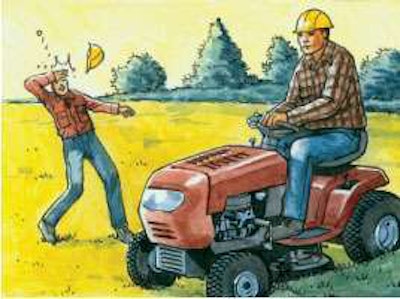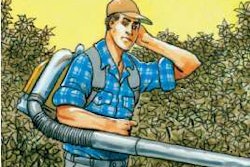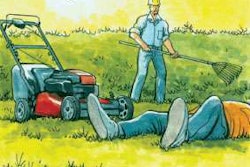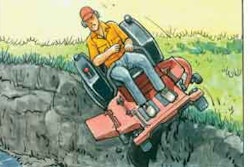
The accident: A 52-year-old landscaper is bending down while placing flagstone along the edge of a newly installed pool when another worker drives a lawn mower past his work space.
He looks up as a small rock flies out from under the mower and hits him in the eye. He is transported to an area hospital where he requires facial and eye surgery. The landscaper suffers permanent loss of vision in his right eye.
The bottom line: The co-worker who was mowing should have considered his surroundings and not mowed past his fellow employee’s work space.
The accident report shows neither worker was using eye protection even though their company provided safety goggles. OSHA-required protective glasses or safety goggles may have prevented this accident.
Both workers said they didn’t like wearing eye protection because their glasses were scratched and often fogged up. The U.S. Bureau of Labor Statistics (BLS) reports nearly 700,000 work-related eye injuries happen each year.
Many of these can be prevented with good eye-protection practices and the use of protective eyewear. In fact, the BLS found that nearly three out of every five workers injured were not wearing eye protection, and almost 70 percent of the accidents resulted from flying objects hitting the eye.
The latest safety glasses are lightweight and provide protection from many harmful UV rays. Long term exposure to UV rays is a major contributor to cataracts.Your employer is required by federal law to provide eye protection that meets ANSI Z-87.1 standards. This information is located on the right side of the earpiece. If your company isn’t supplying this safety gear, you can call (800) 321-OSHA, the agency’s hotline for reporting workplace safety and health hazards.
Here are some tips for preventing eye injuries:
• Always use safety glasses or goggles when mowing, cutting trees, using any machinery or power tools and when working with chemicals or around dust, which is in the air when you till soil or break up rocks or concrete.
• Use a face shield in addition to safety glasses or goggles when working with chippers, shredders or tree trimmers.
• Make sure your eyewear is clean and not scratched.
• Ensure your protective eyewear fits properly.
• Make sure you know where eyewash stations are set up for easy access when working around chemicals.
• Get regular vision check-ups.
• Purchase prescription safety glasses if you require corrective lenses. Note: Your employer must pay for necessary personal protective equipment, but prescriptive eyewear is one of the exceptions.
By Carolyn Magner Mason










